Gluten-free bread isn’t easy to make. As a person who has been gluten-free since before it was a thing, even I have to admit that gluten is basically the reason why bread exists! This is why it is VERY important to have a good gluten-free bread flour blend.
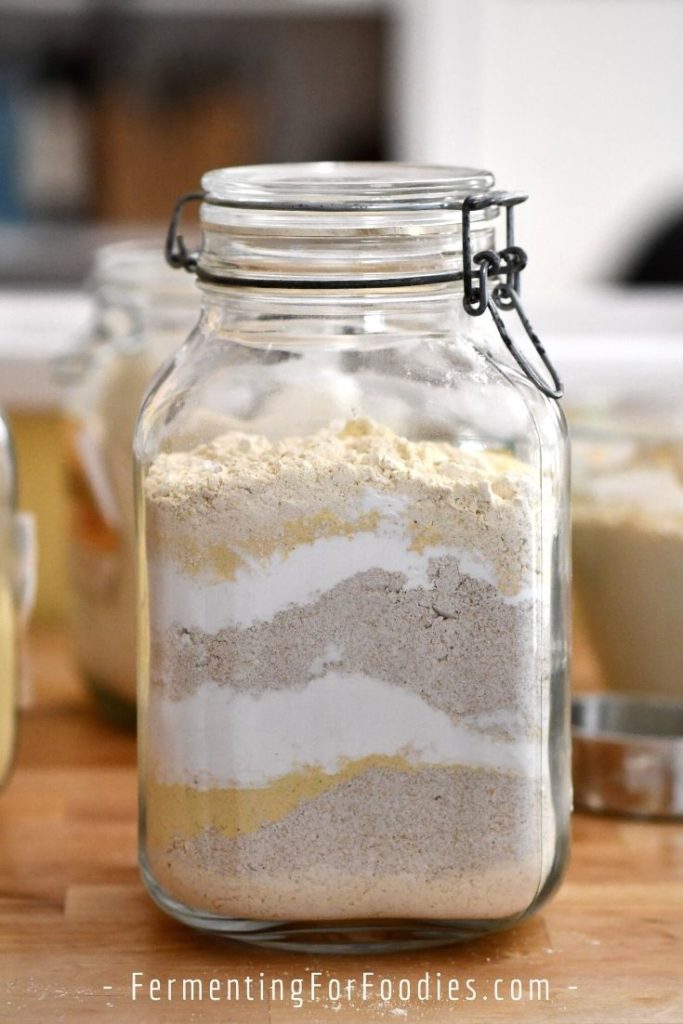
To be honest, I never used to bother with bread at all. However, when my son also ended up on a gluten-free diet I felt obliged to come up with a decent gluten-free bread recipe.
Since then, I have spent a lot of time experimenting, and have created several different gluten-free bread recipes. One of the secrets to a good gluten-free loaf is a good gluten-free flour mix!
Bread Flour Mix
Many people on a GF diet have other sensitivities that make it difficult to use a generic flour mix. For example, I just don’t do well with sorghum, corn, or rice.
This is the main reason why I created a mix-your-own bread flour recipe. So that everyone can use their favorite flours! It’s also perfect for experimenting. Play around with different flour combinations to create your own personal favorite.
If you have a particular combination that you want to share, leave a note in the comments section, and I will be sure to try it out!
The only trick to mixing your own bread flour is that the hydration ratio of each flour is slightly different. So you may need to adjust your recipe account for that. While it doesn’t actually matter for my sandwich bread, any recipe that requires kneading the dough may need to be adjusted.
Types of Flour
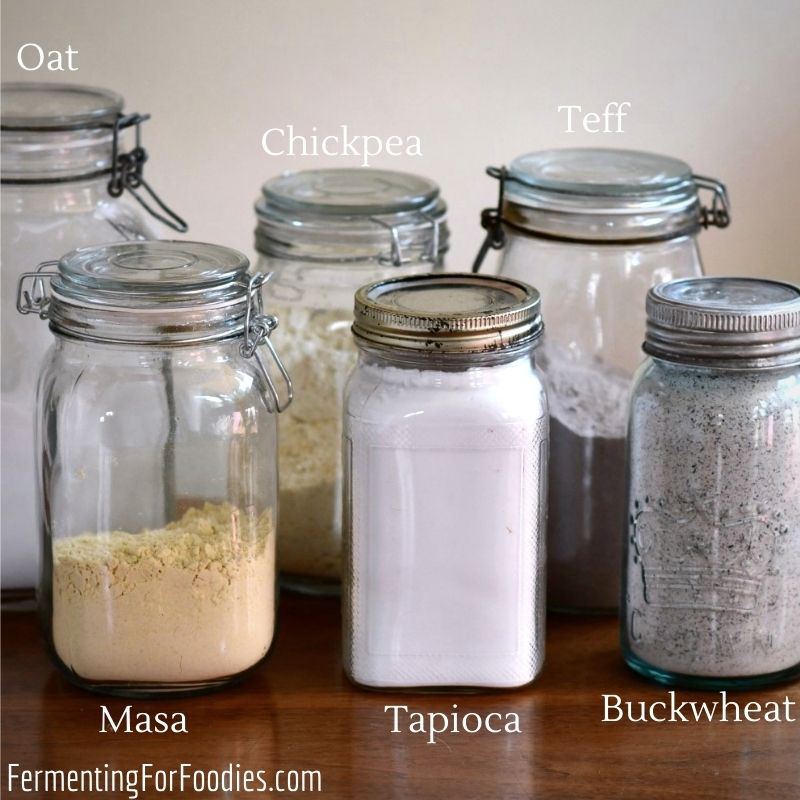
Here are the four types of flour that go into this bread flour mix.
I’ve listed several examples of each, italicizing my favorite flours. If you have a particular food sensitivity and are unable to use bean flour (which is included to increase the protein content) or one of the light flours (which adds a softness), then feel free to leave them out. The mix will work with just a combination of whole-grain flour and starch.
In general, I recommend avoiding rice flour, which is what makes GF baking taste dry and cardboard-like. Any other wholegrain flour will give the baked goods a bit more flavor.
- Wholegrain Flours: buckwheat flour, oat flour, brown rice flour, quinoa flour, millet flour, sorghum flour, or teff flour. If you want a white bread flour mix, then replace the wholegrain flour with white rice flour or light buckwheat flour.
- Starches: potato starch, tapioca flour, sweet rice flour, arrowroot flour, or cornstarch.
- Bean Flours: chickpea flour, urad flour, fava bean flour, soy flour. Bean flours increase the protein content and aren’t required as a binder. Feel free to skip if you have trouble with beans.
- Light Flours: almond flour, masa harina, white rice flour.
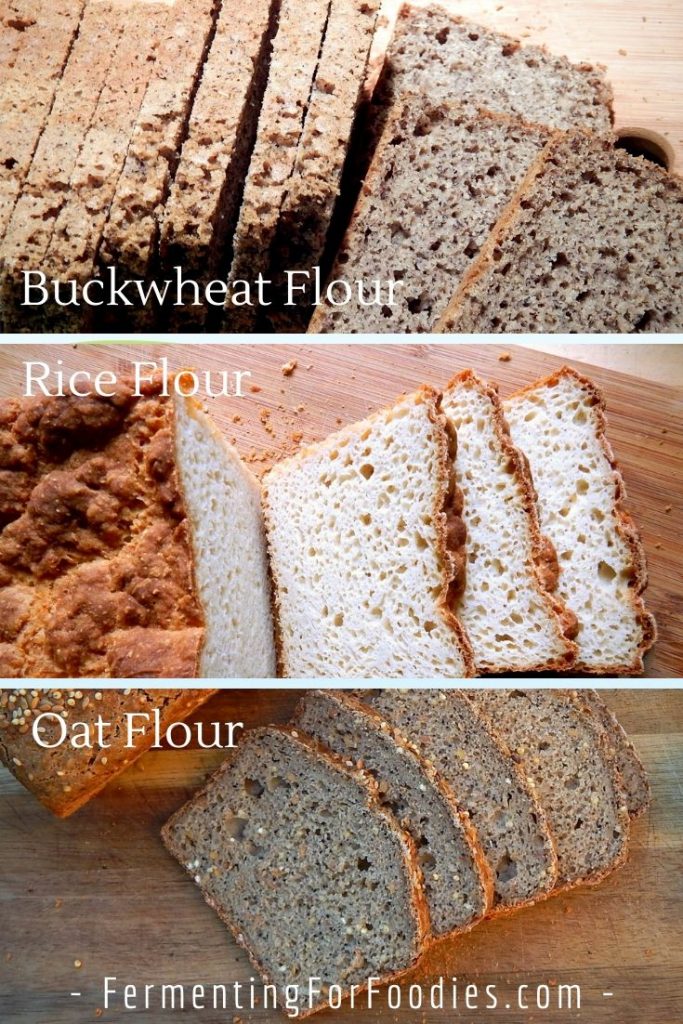
Gluten Free Bread Flour Mix
This basic bread flour mix is perfect for baking gluten-free bread. See the section above for details on the different types of flours that can be used to make this well-balanced mix.
- Prep Time: 5 minutes
- Total Time: 5 minutes
- Yield: 4 cups 1x
- Category: Bread
- Diet: Gluten Free
Ingredients
- 1 1/2 cups whole grain flour
- 1 cup starch
- 1/2 cup light flour
- 1/2 cup bean flour
- Optional: 1 Tbsp xanthan gum
Instructions
- I’ve listed examples of each of the types of flour above so that you can use whatever flour works best for you.
- This recipe can be doubled or tripled if you want to make a large batch of flour. I usually mix up a large 3-quart jar of bread flour about once every 2 to 3 months.
- If you’re making a large batch measure each of the flours for the smaller batch several times. This will help layer them in your storage container. Otherwise, it can be hard to get 4 1/2 cups of oat flour to fully mix into 3 cups of starch!
- If you are unable to tolerate bean flours, then feel free to leave them out. While it does add some binding properties, it’s primarily included to increase the protein content of the flour mix.
Notes
- I have a different flour mix for gluten-free cookies, muffins, and other baked goods. It is softer and doesn’t use bean flour.
- Each gluten-free flour has its own hydration ratio. For example, oat and rice flours absorb a lot more liquid than quinoa flour. So you may need to adjust your favorite bread recipe accordingly.
- Xanthan gum is great at improving the structure of gluten-free baking, however, it’s not necessary for this flour blend. Most of my recipes specifically call for xanthan gum or psyllium husk. However, adding xanthan gum will make this flour more similar to a commercial blend, and work better for recipes calling for a cup-for-cup style gluten-free flour blend.
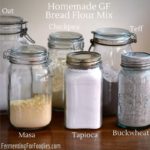


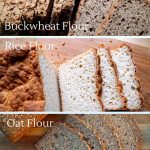


I just found your site! Your site and recipes are fantastic! Can this recipe be used for a gluten free sourdough bread?
Thanks!
Sharon
Thanks! I’ve slowly worked on my GF bread recipe since posting this flour mix. Check out the GF Sourdough category link to see all my sourdough bread recipes. Or the GF link for other types of bread recipes.
Hi, is there a way I can make the gf flour mix without bean flour? What would be s good substitute?
You could either skip the bean flour altogether or replace it with one of the white flours. Masa and rice flour are both quite similar. Cheers!
Can you give me more specific ingredient direction for this recipe flour mixes please?
The recommended types of flour are in the section above, as there are really lots of choices. However, you could use 1 1/2 cup oat flour, 1 1/2 cup tapioca starch, 1/2 cup almond flour, and 1/2 cup of chickpea flour. Enjoy!
my partner thinks he may be sensitive to gluten and lactose, found your site and made a bread. you can tell it’s not the supermarket kind, but it tastes great! thank you so much!
Glad you enjoyed it! 🙂
Any instructions on temperature and time for baking the bread?
Hi Liz! This is a flour mix that I use in several recipes. 🙂 Here’s my basic sandwich loaf: https://www.fermentingforfoodies.com/amazing-gluten-free-sourdough-bread/ I also use it for making bagels, pizza, cinnamon buns. I think it would work for any GF recipe calling for GF bread flour. Cheers!
I just found your site because we’re not really happy with the GF ready pizza crusts or quick pizza dough recipes… Used to make our own wheat-based sourdough pizza every week, but now two of us can no longer have it. Am excited to try your pizza recipe (already have my starter going), but I’m stuck at the 1c of bean flour for the bread flour mix. Beans (soaked as well as fermented and even sprouted) are making my family sick, so I’m wondering if I can substitute the bean flour with some other. Are the beans providing protein or fiber in this mix? Thank you, Dee
Beans provide both protein and thickening/stickiness. I would suggest replacing with rice or oat flour. Hope it works for you!
Thank you so much, Emillie! I will try one of those. 😉
Do you have a good source of potato starch or tapioca starch? They seem very expensive when I’ve seen them on store shelves around Victoria. Wondering if you’ve found any good deals… 🙂
I used to shop at Ingredients, and was so sad when they closed. Now I pretty much buy everything online at Organic Matters (out of Nelson, BC). However, starch is still expensive. I only use it for bread and cakes. Otherwise, I just use straight GF oat flour.
Try asian groceries! You can get a 500g bag of tapioca starch for a dollar or two!
Clever girl that’s what I do, African and Hindu are great sourcing for millet and sorghum
Great advice! Thanks!
You have the started sourdough recipe for gluten-free bread And than the flour mix you use but you don’t say how much of the started you use the flour mix. Do you use it all or part like most wheat starters?
I use what is needed for my recipe. I usually start everything I need all at once. So 2-4 cups of flour depending on how much baking I’m doing. I find that I don’t need the process of feeding or building extra starter as long as I use some buckwheat in my GF blend.
My dad has just gone GF. He has been making his own sour dough starter bread for years and it is always fluffy and light. Which flour combo do you recommend to replace his white bread with 7 grain added. Thank you in advance
White rice is the usual white flour replacement. However, I find it makes baked good dry and tasteless. Buckwheat flour is amazing for catching sourdough starter (takes 2-3 days). I usually start it with buckwheat flour, then move to oat flour. I like oat flour for my baking because it is flavourful and oats have that natural stickiness. Oats are GF, they just are often processed in the same mills and wheat flour. So if he’s celiac, then you should look for GF oats.
Im new to the GF world, what would coconut flour be considered? And what it be used best in?
Welcome to the GF world! Coconut flour isn’t like other GF flours at all. It absorbs a LOT of liquid. It won’t catch a sourdough ferment. It also has a unique flavour. I recommend it for sweet baking.
My wife just got diagnosed as cilia. Tried buckwheat, almond, chickpea and potato starch, with my bread maker (GF setting) and a oatmeal loaf recipe. I added the same amount of water, as I would usually add for wheat, seemed like way too much. The final loaf was a brick. Experimented much with GF flour and bread makers?
I was diagnosed with a gluten allergy 11 years ago… 🙂 You can’t just use a gf bread flour in a regular bread mix. I have several bread recipes on this blog and love them all. Just look in the GF section and pick what works for you! https://www.fermentingforfoodies.com/category/special-diets/gluten-free/
Hello Emilia can I’m not gluten free but I love the idea of using bean flour and nut flour as vegetarian can I use wheat flour mixed with rice flour for the first ingredient thank you
Great! It’s an easy way to increase the protein content of food!
Thank you Emillie I’ll try it next week
What alternative would you suggest for bean flour?
As I can’t digest most all beans, especially chickpea and fava.
You could either skip the bean flour altogether or replace it with almond or masa flour. Cheers!
Hello! A lot of very useful information on your website! Thank you for sharing! As white flour, I don’t have rice flour at home (nowadays it’s difficult to find ingredients at supermarkets), I live in Italy so here we have polenta instead of masa. Can I use polenta as white flour? It is quite grainy so I was a bit skeptical.
Polenta is not the same as masa. Masa is an extremely fine flour. I would just replace it with more wholegrain flour. The key is having a balance between the starch and the grain. The white flour adds texture, but it’s not integral. Good luck and take care.
Thanks a lot for your reply Emillie! I followed your instruction for the flour blend (instead of white flour which I couldn’t find, I used more whole grain flour) and prepared a pizza dough with dry brewer’s yeast. As flour mix I used millet, buckwheat, chickpea flours, corn and potato starches. Then for my “trial” pizza dough, I used 140 gr of this blend together with 100 gr of water, 1/8 teaspoon of dry brewer’s yeast (dissolved and activated in water with 1/8 teaspoon of sugar), and 1/8 teaspoon of vinegar (I read somewhere that it could help rise the dough). Then I kneaded it for 3 times at different time intervals and left in the fridge for 24 hours for a long fermentation. The pizza was very tasty but the dough was not sticky and not risen a lot. In the end the pizza came out thin and crispy at the borders. I am very new to this world and I try to learn. It was my first trial to adapt my classical wheat pizza dough for a gluten free version. But I see that it is not so straightforward. I saw that you have many recipes with sour dough. Do you have any suggestions for the use of brewer’s yeast in GF bread/pizza doughs? Thank you again for your availability and all the useful tips and tricks that you’re providing us.
Hi! GF recipes are a bit tricky, as they always use odd ingredients (starches, gum, etc) to simulate the texture of wheat. I usually always use a sourdough starter for my baking, as fermenting GF flour really improves the texture and flavour. I have also made this quick yeast pizza crust in the past: https://minimalistbaker.com/the-best-gluten-free-pizza-crust-sauce/ Enjoy!
Thank you Emillie! I’ll check the pizza recipe and the option of sourdough starter, too!
What is the purpose of the bean flour in the mix? I ask because at this time I don’t have any bean flours but would love to make your mix to try baking with. I like that I can pick and choose from types of flour. I’m just wondering if there’s any way to sub out the bean flour part.
The bean flour absorbs water (similar to rice flour and starch) but without the added bland/cardboard flavour. 🙂 However, too much bean flavour is overwhelming too! If you don’t have bean flour, feel free to replace it with any whole grain flour. Cheers!
Emily,
I tried the bread recipe and it was great! I used oat sourdough, with corn, garbanzo, oat and coconut flour. I used sweet rice flour and corn starch. The problem: I don’t do well with starches. It feeds a low grade yeast/bacteria situation. I thought I’d try it though and see. Unfortunately I couldn’t tolerate the starch and I did reduce it by a half cup. I’d like to try with out the starch and I was just curious if there was anything you recommend? And have you ever left out the starch? And if you did what happened.
Thanks!
Often I bake with 100% whole grain flour (oat or buckwheat). However, a blend tends to do better. Maybe try replacing the starch with a mix of oat flour and masa? Oat will absorb the liquid and masa will give the flour lightness. Enjoy!
Hi Emillie! Thank you very much for all this valuable information! Since January of this year I started ketogenic lifestyle but now that I have reached my ideal weight, I mix it with a low carb lifestyle. Among your ingredients I saw arrowroot and almond flour, but I can’t consume whole wheat flour (i love oat flour) or bean flour. By any chance, do you have a recipe that fits my lifestyle? And another question, can I make my sourdough with almond flour? I’ve read that you can use any flour and they give examples, but they don’t mention almond. THANK YOU SOOOO MUCH!
Hi Paula, Congrats on reaching your ideal weight! Sourdough feeds on the complex carbs found in grains. So you’ll need to use a grain-based flour to make sourdough. However, oat flour is what I use for my sourdough, so that should work fine for you. It will take you about 5 to 7 days to catch a good starter with oat flour. You can follow my instructions, which don’t have you feeding until you’ve caught the starter.
As for baking… why not try this recipe: https://www.fermentingforfoodies.com/perfect-gluten-free-sourdough-buns/ It is fairly low carb and doesn’t require bean flours or anything like that. Best of all, the bread is really amazing! I’m working on a loaf-based version, but haven’t had time to properly photograph it and write up the blog post yet. 🙂 Probably will get to that sometime in January.
Be well, Emillie
For the whole grain flour, could I use a mix of flours? Amaranth and buckwheat and oat for example, or would I get a better result by using just one kind of flour?
Using a mix of flours is fine. I’m always using a mix of whatever I have on hand. My only recommendation is in regards to using GF sourdough. You’ll want to make sure that your flour mix contains a good portion of the flour you are using to feed your sourdough starter. GF sourdough isn’t as vigorous if you’re swapping flours.
Hello. Last year I tried to make GF Sourdough bread and was very disappointed in it. After browsing through your site I understand why and am going to try again with information you have wonderfully provided. My buckwheat starter is beginning to ferment nicely. I am questioning what is going to happen when I bake from the buckwheat starter using different flours in the bread. Do I have to make a starter using primarily the specific fours I plan to make the bread with? My plan was to use a blend of rice and oat flour as the whole grain flours.
Thank you
Sharon
Glad it worked out for you! I recommend including some buckwheat in the mix for your baking. Since you used buckwheat for the starter, the yeasts will thrive best on more buckwheat. I actually played with this just last weekend and switching the type of flour resulted in a much denser bread.
Regarding your bread mix, Can you mix and use 2 or 3 whole grain flours or should you just pick one?
Also, where do you get your potato starch so it’s a healthy one?
I have never used a bean flour so I guess I’ll have to try stunting new!
Feel free to mix different whole grain flours. It will just add to the depth of flavour. As for potato starch, I’ve been buying most of my GF ingredients online from a place called Organic Matters (https://www.omfoods.com/). I’m not an affiliate or anything… so this is an honest recommendation. However, the best value comes from buying large amounts. And the only product of theirs I haven’t enjoyed is their oat flour. For some reason it was bitter. Enjoy!
Would it be possible to sub out the bean flour? I’m following Dr Gundrys Plant paradox diet and beans are a no no.
I want to make home made fresh gluten free chinese egg noodles to stir fry. Have you tried this? The recipe calls for a gluten free bread mix. Would rather mix my own. Have quite a collection of gf flours to work with now. I just don’t want them falling apart in the pan. Have a pasta rollers for my kitchenaid.
I haven’t made egg noodles, though I imagine this should work! Let me know how it goes.
Could I use only light flour instead of whole grain and light flour? I’m trying to make a low carb sourdough.
If you want a low-carb sourdough, you should probably use a specific low-carb recipe. If you just use almond flour, then it won’t have the right moisture absorption and stickiness. I also haven’t tried making sourdough without any grain. I have a recipe that uses sourdough starter for the flavor, but the rest of the bread is low-carb. https://www.fermentingforfoodies.com/perfect-gluten-free-sourdough-buns/ It’s actually one of my favorites! The exact amount of carbs will depend on how long you let the sourdough starter ferment. If it doesn’t work for you, then I recommend checking out a keto-specific site. Cheers! Emillie
I’m curious if you’ve used Cassava flour for bread making. I’ve heard it’s a great replacement for regular flour (almost cup for cup).
I haven’t baked with cassava. It’s not very common where I live. Sorry, I can’t help or offer suggestions. Cheers, Emillie
Thank you so much for this great article to help us create our own bread flour mix! I am currently trying out the recipe and doubling it. For the ‘Light Flour,’ however, I just ran out of almond flour (after putting 1/2 cup in my mixture), but I have some coconut flour and wondering if I can use another 1/2 cup of it (instead of the almond flour) to double the recipe. Would that work?
Unfortunately, coconut flour is not the same as almond or masa. It absorbs a ton of water. It’s probably best just skip the extra light flour. Cheers!
Thank you for your comment to let me know! I appreciate it!
This recipe is great (and so are the explanations of the different flour types you can mix). Really worked like a charm for bread and pasta too, no additives needed. Thank you SO much for sharing this! I just discovered I can’t eat gluten anymore, and having an xanthan-free bread has been a life-saver.
Thanks for sharing! I’ve never tried making pasta with this flour mix… but now I’m inspired to try!
I’m going to make a experimental gluten free bread, but I would like it to be a success
The ingredients are; Gluten free flour and gluten free chickpea flour and egg white for it, to rise …..Or maybe yogurt ( no sugar) because the taste of bread when it been done with yogurt is divine Yuli
I’m so happy I found you
Great! I have a few different GF bread recipes on my site. But it sounds like you have something specific in mind. I have used yogurt to rise bread, and often include eggs for structure. Cheers!